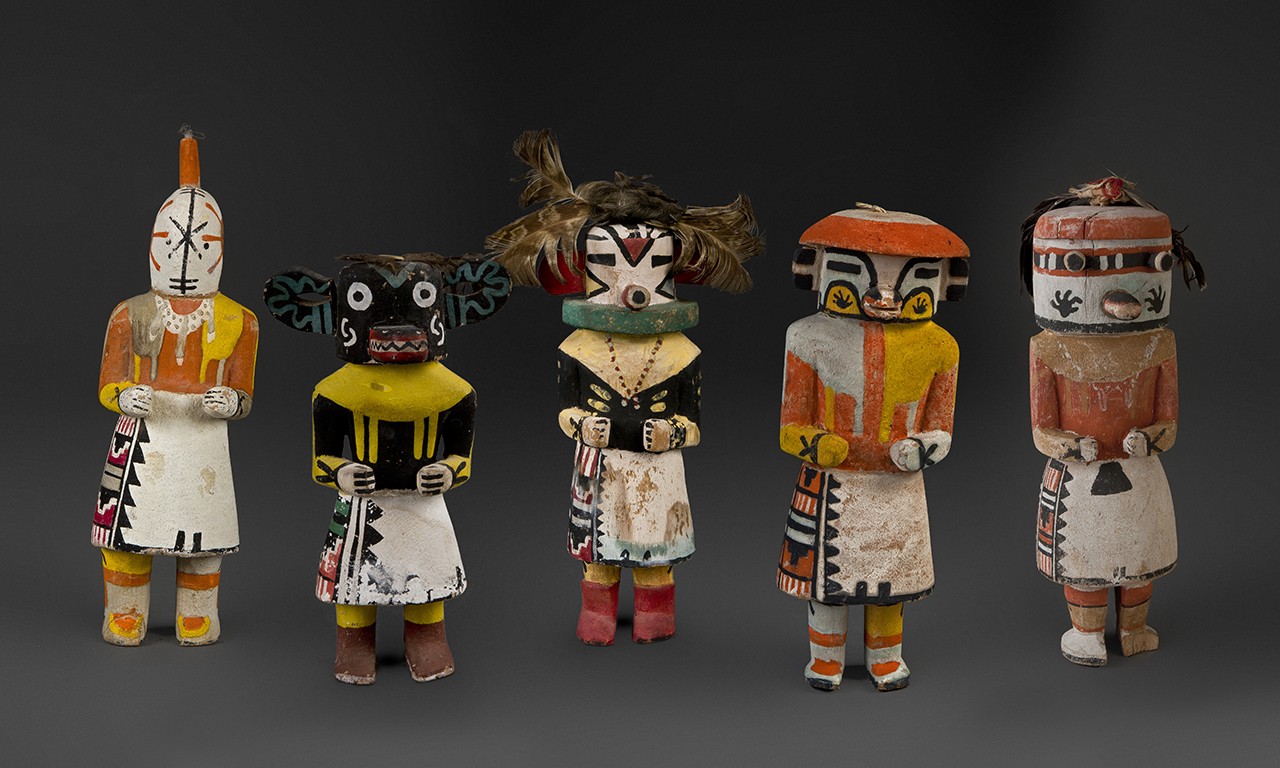 |
Katsina Figures (Tithu), late 19th to mid 20th Century
Hopi culture; Arizona
Cottonwood root, pigment, and various mediums
88.7.1, 89.1.17, 89.1.18, 7480, and 20630
Gifts of John J. Hawkins, June Kennady Robertson, Miss Prudence Brown, and Mary J. Newland |
The Earth, The Air, and Everything In Between
The Hopi, Zuni, and other Puebloan peoples believe in spirits that represent animate and inanimate objects, entities, and forces from the physical and non-physical realms; in Hopi, these spirits are called katsinam (singular is katsina; kachina is an alternate, non-preferential spelling that may be more familiar to some). Katsinam play an important role in maintaining the harmony of the world and linking the physical and invisible worlds. Although katsinam are said to have once been visible to humans and dwelt among us, today they manifest themselves through masked Hopi dancers who perform the various katsinam ceremonies held between the months of December and July of each year. Katsina figures, called tithu (singular is tihu) in Hopi, are not representations of the spirits themselves, but of these masked dancers. This post looks at a selection of Hopi tithu and discusses their creation, use, and the identities of the featured katsina figures.

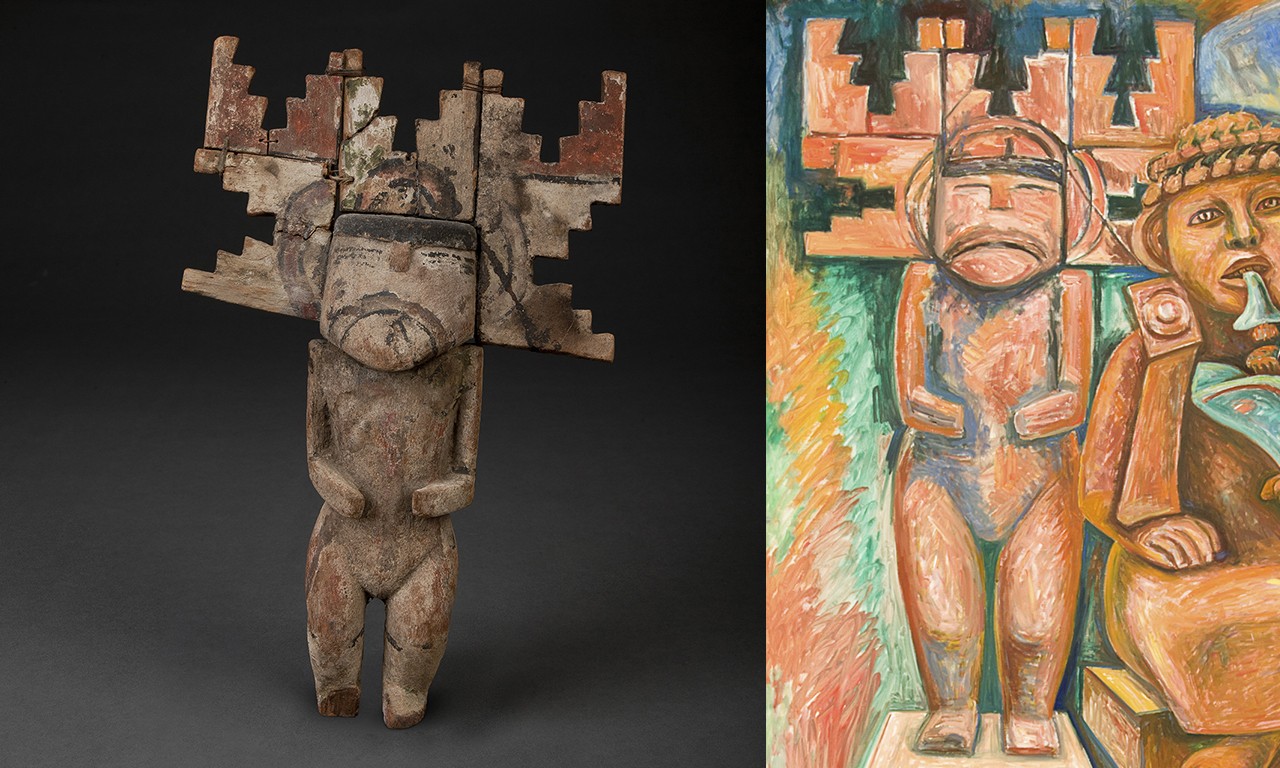 |
Shalako Mana Katsina (Tihu), 1870-1910
Hopi culture; Northeastern Arizona
Cottonwood root, pigment and cotton thread; 12 1/2 x 8 1/4 x 2 5/8 in.
F79.35.1
Bowers Museum Foundation Purchase with a matching grant from Rockwell International Orange County Facilities |
Detail of Untitled (Artworks of the Bowers Museum), 1999
Raúl Anguiano (Mexican, 1915-2006)
Oil on canvas; 101 1/2 × 183 1/2 × 1 1/2 in.
99.63.1
Gift of Bowers Museum Collectors Council |
Two Centuries of Tithu
Katsina figures have probably been made for a little more than two hundred years. The very earliest examples appear to date back to the 18th century and tended to be rectangular with little detailed carving. The evolution of their form over time has been highly organic, punctuated with the creation of new types of tithu and has generally trended toward more complex forms painted with brighter colors. The above katsina figure is typical of the period between 1870 and 1910. It can be identified from its tablita headdress and painted white face to represent Shalako Mana, the female companion of the male Shalako Taka katsina. These two katsinam are seen together during the Shalako Dance, a rare dance performed on the Second Mesa every twenty to thirty years. The 1870 to 1910 stylistic period is distinguished from the earlier styles by the sculptured legs, which are individually carved, and which attempt to portray the dynamic motion of the actual katsina dancer. This was an innovative and revolutionary development in the state of katsina carving. This particular tihu is featured in the 1999 mural of Bowers art created by Raúl Anguiano.

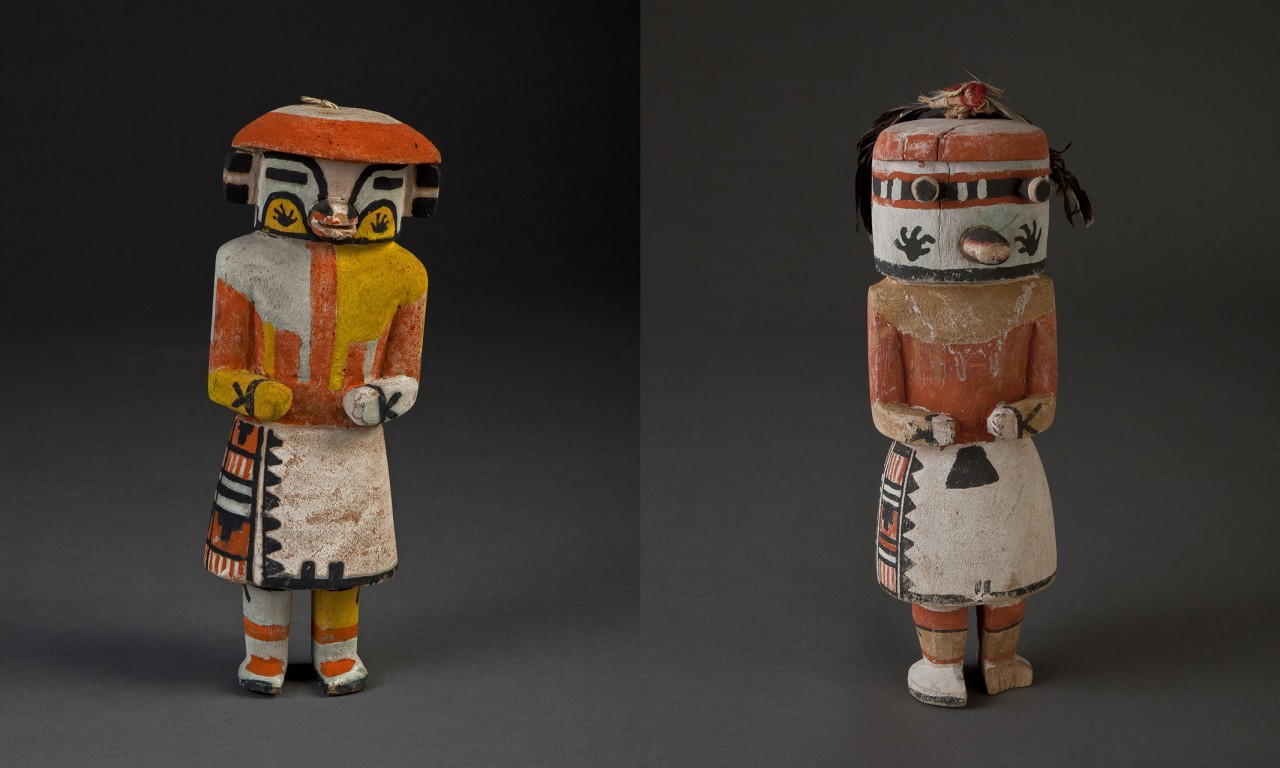 |
Possibly Sakun (Red Squirrel) Katsina (Tihu), late 19th to early 20th Century
Hopi culture; Walpi, Arizona
Cottonwood root and pigment; 9 7/8 x 3 5/8 x 3 in.
7480
Gift of Miss Prudence Brown |
Ewoto or Susukholi Katsina (Tihu), c. 1930
Hopi culture; Arizona
Cottonwood root, pigment, cotton thread, wild turkey feather and corn husk; 13 1/2 x 7 3/8 x 3 1/4 in.
20630
Gift of Mary J. Newland |
Didactic, Not Dolls
Tithu are not themselves used in dances, nor do they function as toys as might be suggested by their often being referred to as “kachina dolls;” their function is didactic. Pueblo religion has traditionally been male dominated. These figures are given to women, especially children, to assist them in learning the vast Hopi pantheon. There are hundreds of individual katsinam and many villages will have unique variations of each katsina. Due to the evolution of katsinam over time, their physical attributes have changed, and individual carvers also have added their own particular stylistic interpretations to both the costumes worn by dancers and tithu. Some carvers consciously change or omit certain details when they make figures intended for sale to non-Hopi. Thus, the precise identification of the carvings can sometimes be difficult. The two tithu above are excellent examples of early 20th century katsina carvings, although neither has been formally identified.

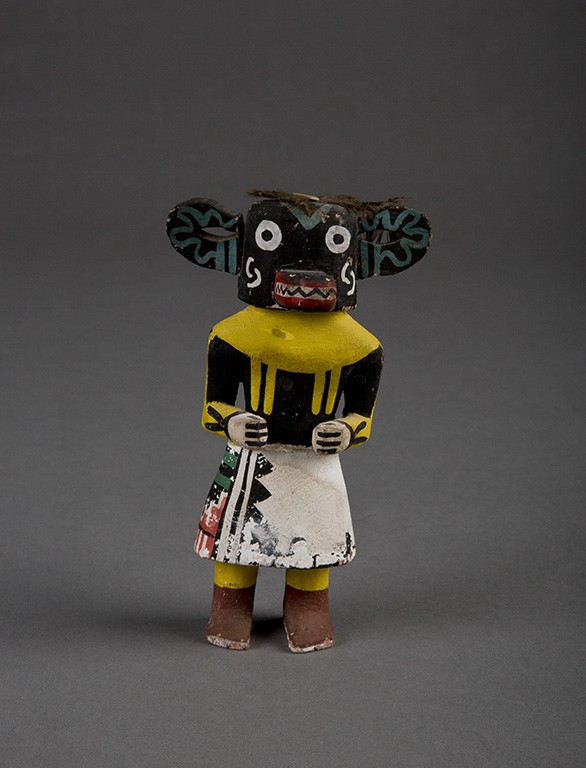 |
Yellow A’hote Katsina (Tihu), c. 1960
Hopi culture; Arizona
Cottonwood root, pigment and pheasant feather; 6 3/8 × 3 3/4 × 1 5/8 in.
89.1.17
From the Collection of June Kennady Robertson |
In General
Little tends to be known about the individuals who carved older examples of katsina figures—none of the Bowers tithu have notes about their makers—but a few generalities about their creation apply. Firstly, all tithu that were intended for traditional Hopi use were carved by men. Boys tended to learn how to carve katsina figures from family members as part of religious initiation rituals. Secondly, all tithu are made from the root of the cottonwood tree. Cottonwood tends to grow near sources of water, a scarce resource in the desert landscape in which the Hopi live. Both the tree and katsina figures share in bringing plenty to the Hopi.
The figure above is Yellow A’hote, one of the messenger katsinam who deliver prayers from Hopi to the gods during mixed katsina ceremonies.
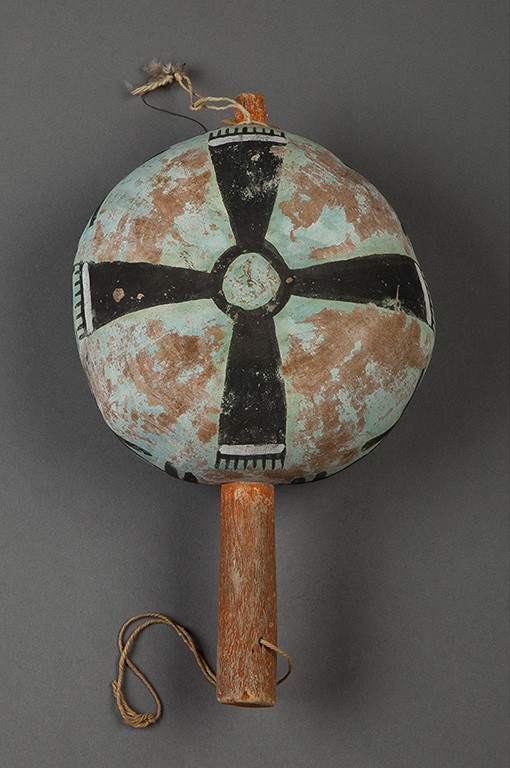 |
Dance Rattle, c. 1950
Hopi culture; Arizona
Gourd, wood, pigment, cotton string and pheasant feather;10 1/4 x 5 7/8 x 3 1/4 in.
91.9.1
Helen Thayer, Orange, California |
The Cost of a Dance
The costumes and accessories used by katsina dancers are at the center of every major Hopi religious event. This rattle is a common style that was employed around the middle of the 20th century. It features a central cross which represents the rain clouds of the four cardinal directions radiating from a universal center. Despite the light weight of the masks worn by Hopi dancers, donning one was a heavy burden as dancers had to temporarily lose their individual identities to assume that of the katsina.
For more tithu in the Bowers permanent collection, follow this link to our Digital Collection: https://collections.bowers.org/search/katsina. Text and images may be under copyright. Please contact Collection Department for permission to use. Information subject to change upon further research.






Comments 1
Is there a chance of a future exhibit of these from The Bowers and other collections?